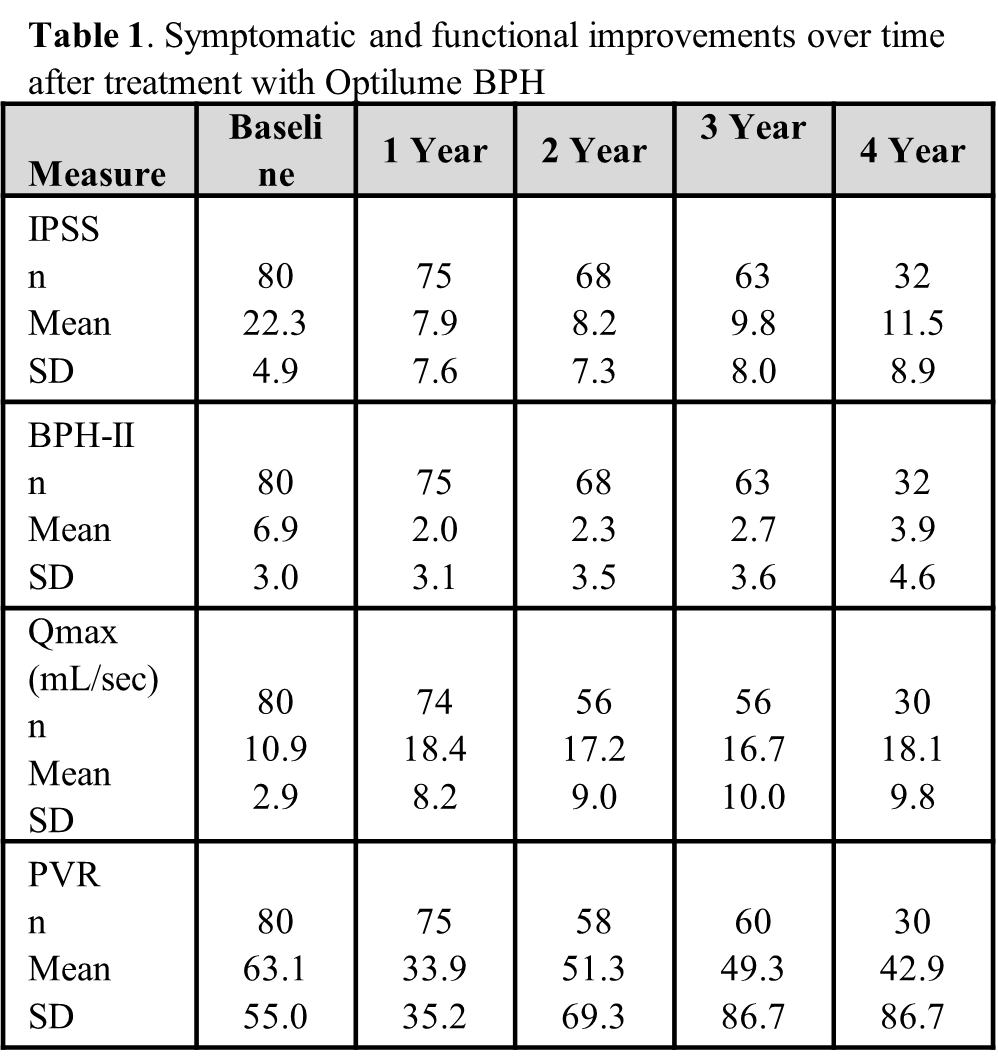Back
Introduction: The EVEREST-I study is a prospective, single arm, multicenter study evaluating functional improvement in urine flow and improvement in lower urinary tract symptoms (LUTS) after treatment with the Optilume BPH System, a novel minimally-invasive treatment for Benign Prostatic Hyperplasia (BPH). Optilume BPH utilizes mechanical dilation of the prostatic urethra to achieve an anterior commissurotomy while delivering the drug paclitaxel to maintain long-term urethral patency.
Methods: A total of 80 subjects were enrolled at 6 centers. Follow up is ongoing, with 32 of 72 expected subjects with 4-year follow-up complete. Symptom improvement was measured utilizing the International Prostate Symptom Score (IPSS) and BPH Impact Index (BPH-II), functional improvement measured by peak urinary flow rate (Qmax) and post-void residual volume (PVR).
Results: Mean Qmax showed an immediate increase from 10.9 mL/sec at baseline to 18.8 mL/sec at 14 days, which was sustained at 18.1 mL/sec through 4 years post treatment (p < 0.001 vs baseline). A paired analysis of those subjects completing the 4-year visit showed a steady Qmax compared to 3-year outcomes (18.1 vs 18.8, p=0.54). IPSS and BPH-II showed significant, immediate improvement from baseline with this improvement maintained through the 4-year follow-up (Table 1). Erectile and ejaculatory function scores were not significantly changed from baseline through 4 years.
Conclusions: The Optilume BPH Catheter System combines mechanical and pharmaceutical aspects for the treatment of BPH, resulting in both an immediate functional improvement by way of creating an anterior commissurotomy and a sustained anatomic result due to the application of paclitaxel to the prostatic urethra during the initial dilation. The functional and symptomatic improvements seen after treatment with Optilume BPH have been sustained through 4 years in this early feasibility study. The sustained improvement in Qmax is superior to any minimally invasive BPH device currently approved. Results from the EVEREST study will be further verified in the ongoing randomized, sham controlled PINNACLE study. SOURCE OF
Funding: This study was funded by Urotronic, Inc.

Moderated Poster Session
Session: MP76: Benign Prostatic Hyperplasia: Surgical Therapy & New Technology IV
MP76-02: At 4 Years, Optilume BPH Has the Highest Sustained Improvement in Peak Flow (Qmax) of Any Minimally Invasive BPH Therapy
Monday, May 1, 2023
9:30 AM – 11:30 AM CST
Location: S405
- SK
Steven Abraham Kaplan, MD
Icahn School of Medicine at Mount Sinai
Poster Presenter(s)
Introduction: The EVEREST-I study is a prospective, single arm, multicenter study evaluating functional improvement in urine flow and improvement in lower urinary tract symptoms (LUTS) after treatment with the Optilume BPH System, a novel minimally-invasive treatment for Benign Prostatic Hyperplasia (BPH). Optilume BPH utilizes mechanical dilation of the prostatic urethra to achieve an anterior commissurotomy while delivering the drug paclitaxel to maintain long-term urethral patency.
Methods: A total of 80 subjects were enrolled at 6 centers. Follow up is ongoing, with 32 of 72 expected subjects with 4-year follow-up complete. Symptom improvement was measured utilizing the International Prostate Symptom Score (IPSS) and BPH Impact Index (BPH-II), functional improvement measured by peak urinary flow rate (Qmax) and post-void residual volume (PVR).
Results: Mean Qmax showed an immediate increase from 10.9 mL/sec at baseline to 18.8 mL/sec at 14 days, which was sustained at 18.1 mL/sec through 4 years post treatment (p < 0.001 vs baseline). A paired analysis of those subjects completing the 4-year visit showed a steady Qmax compared to 3-year outcomes (18.1 vs 18.8, p=0.54). IPSS and BPH-II showed significant, immediate improvement from baseline with this improvement maintained through the 4-year follow-up (Table 1). Erectile and ejaculatory function scores were not significantly changed from baseline through 4 years.
Conclusions: The Optilume BPH Catheter System combines mechanical and pharmaceutical aspects for the treatment of BPH, resulting in both an immediate functional improvement by way of creating an anterior commissurotomy and a sustained anatomic result due to the application of paclitaxel to the prostatic urethra during the initial dilation. The functional and symptomatic improvements seen after treatment with Optilume BPH have been sustained through 4 years in this early feasibility study. The sustained improvement in Qmax is superior to any minimally invasive BPH device currently approved. Results from the EVEREST study will be further verified in the ongoing randomized, sham controlled PINNACLE study. SOURCE OF
Funding: This study was funded by Urotronic, Inc.

